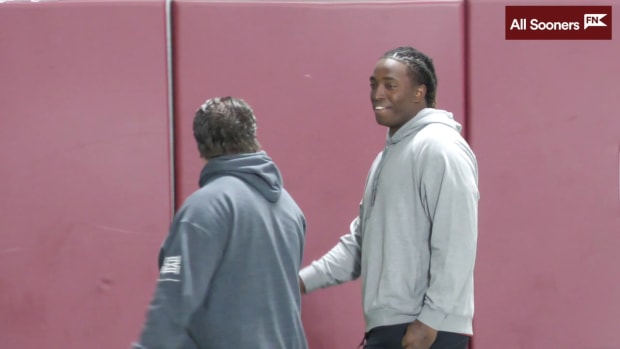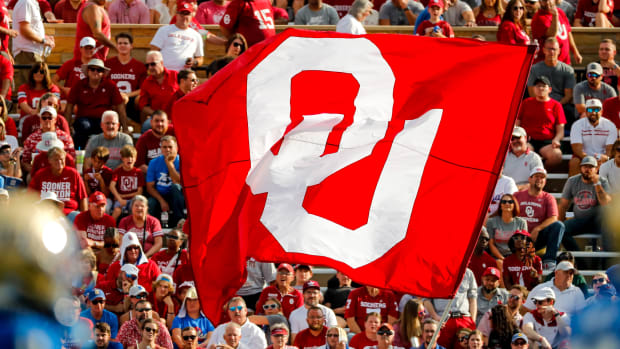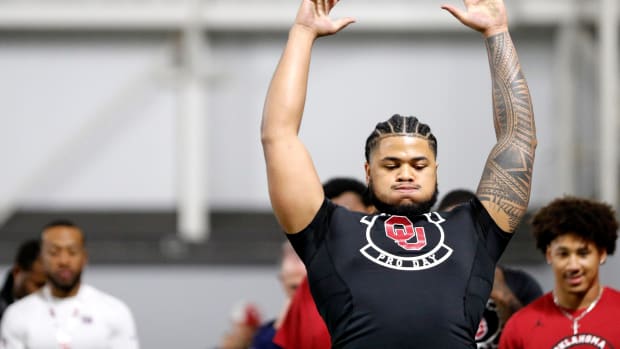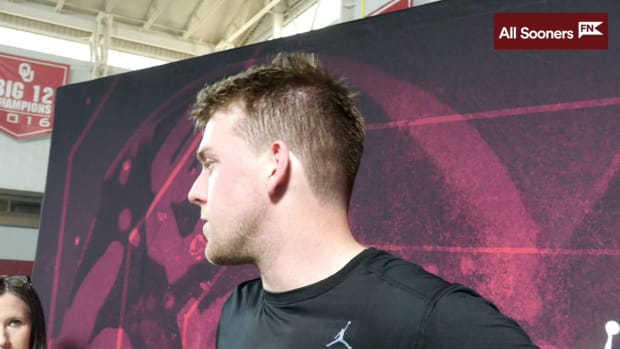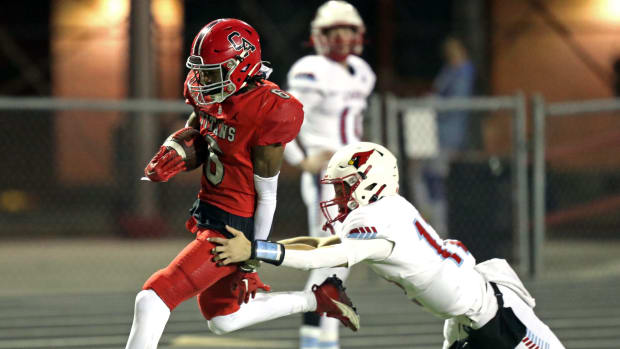Hang Half-a-Hundred on 'Em: Looking Back on OU's 50 Conference Titles, Part 5
In 2020, the Oklahoma Sooners won their 50th conference title, four more than second place Nebraska. Every Friday this summer in our Hang Half-a-Hundred on ‘Em series, SI Sooners takes a look back at every single conference championship season in OU history.
1949: Securing a Legend
After rumors swirled all offseason, Bud Wilkinson returned to campus in Norman and signed a new five-year deal, keeping the legend on the sidelines at Oklahoma. Led by experienced quarterback Darrell Royal, the Sooners hoped to build on their momentum from a fruitful 1948 season, and did they ever. Dispatching Boston College and Texas A&M, the Sooners took a 12-game winning streak into Dallas to lock horns with Texas. The Sooners wouldn’t cross the 50-yard line in the first quarter, but kicked things into gear after falling behind 7-0. But late in the game, Royal connected with Jim Owens for a 17-yard touchdown to seal the victory for Oklahoma. Two games later, seven different Sooners scored as OU pounded the Nebraska Cornhuskers 48-0, the largest margin of victory in the rivalry at the time. One week later, OU pounded Iowa State in a game that marked the 200th home game for the Sooners in Norman. A 27-7 victory over the Missouri Tigers clinched Oklahoma’s third straight conference title as Wilkinson’s domination of the conference continued. Finishing the regular season as the No. 2-ranked team in the country, the Sooners returned to the Sugar Bowl to play No. 9 LSU, as Notre Dame was already minted national champions. Anticipating a defensive struggle, the Sooners showed out against the Tigers, hammering them 35-0 in front of 82,000 fans at Tulane Stadium.
1948: Snapping the Streak
Oklahoma survived a rocky start to the season in 1948. Headed to the West Coast, the Sooners held a 17-7 halftime lead over Santa Clara before succumbing to the passing attack of the Broncos. OU would bounce back against Texas A&M before defeating the Texas Longhorns for the first time in eight seasons. Leon Heath opened the scoring for Oklahoma early into the second quarter, capping off a 73-yard drive to break the deadlock. Holding off the ‘Horns, George Thomas picked off Tom Landry’s pass with 15 seconds left to ice the win. Reeling off four more wins, the No. 20-ranked Sooners then stomped the No. 9 Missouri Tigers to take a stranglehold on the Big Seven title race. After dominating Nebraska, Oklahoma pounded the Kansas Jayhawks 60-7 to clinch the program’s ninth conference title. Oklahoma earned a bid to the Sugar Bowl against the No. 3 North Carolina Tar Heels on New Year’s Day. OU was able to slow down North Carolina’s explosive offensive attack led by Charlie Justice, cruising to a 14-6 victory in the season finale.
1947: Wilkinson’s Arrival
Before the 1947 season, Wilkinson was hired as the 13th head coach in OU football history, as well as taking over for Jap Haskell as the athletic director. Implementing the Split-T offense, Wilkinson would have to replace Joe Golding, Warren Giese and Plato Andros. Turning to Jim Owens and Bobby Goad among others, Wilkinson laid the foundation for a football dynasty. It wasn’t a walk in the park, however, as the Sooners stumbled to a 2-2-1 start out of the gate. Defeating Detroit and Texas A&M, OU then lost to Texas 34-14, tied Kansas and then lost to TCU 20-7. But Oklahoma was able to stabilize, and headed to Nebraska with a conference title on the line. A Sooner win and a Kansas loss would hand Oklahoma the outright Big Six title, but both teams emerged victorious, hence splitting the title. OU topped the Huskers 14-13 in a snowy trip to Lincoln before returning home to host Oklahoma A&M. Trailing 13-7 at the end of the third quarter, a fumble set up Oklahoma’s go-ahead touchdown. George Thomas logged six carried for 106 yards, including a 59-yard touchdown run to put the game out of reach with a 21-13 win. After a vote by the team, Wilkinson’s Sooners declined all bowl invites, ending the season 7-2-1.
1944: A War-Time Distraction
Head coach Snorter Luster leaned on Derald Lebow and Charley Heard to lead the Sooners in 1944 despite the ongoing war raging in Europe and Japan. Still, OU opened the season with a loss. Falling 28-14 to Norman’s Naval Air Station Zoomers, OU bounced back a week later with a 21-14 win over the Texas A&M Aggies at Taft Stadium in Oklahoma City. Playing the Longhorns with no Texas State Fair for the third straight year, freshman quarterback Bobby Layne threw a pair of touchdown passes to help lead Texas to a 20-0 victory, the last game Oklahoma would lose that season. Playing to a 21-21 tie against Missouri on Nov. 11, Oklahoma would host Nebraska, again at Taft Stadium, in their season finale. Winning 31-12, the Sooners’ 31 points against Nebraska was the most the Cornhuskers had ever conceded in a game at the time. OU finished the contest with 269 total yards and nine first downs, controlling their rivals and finishing off their Big Six title campaign in style.
1943: First Time Under the Lights
With World War II depleting college rosters across the country, 42 of 44 lettermen didn’t return to the field from OU’s 1942 squad. Yet, coach Dewey “Snorter” Luster led the Sooners to a 7-2 season, capturing the program’s fifth conference title. OU opened the season with a 22-6 win over the Norman Naval Air Station, a team consisting of players who had previously represented 12 different programs. A week later, 12,000 fans packed Taft Stadium to watch Oklahoma defeat Oklahoma A&M 22-13 in the first night game in OU history. The Sooners then dropped two straight games, one to Texas and one to Tulsa, before running the table to close the year. Bob Brumley helped power OU to a 26-7 victory over Nebraska, running for two touchdowns while also totaling 121 rushing yards on the day, as Oklahoma ran for 300 yards as a team against Nebraska. Finishing 5-0 in conference play, Oklahoma was clearly the class of the Big Six in 1943.
1938: First Bowl Trip
Dominated by defense, the 1938 Sooners only gave up 12 points in the regular season en route to OU’s first bowl game in program history. Quarterback Otis Rogers and halfbacks Earl Crowder, Bob Seymour and Gene Corrotto led the OU offense to post a 10-1 record. Edging out Rice in a nervy 7-6 game in the season opener on the back of a Howard McCarty touchdown in the second quarter. Oklahoma improved the next week, topping Texas 20-0 and securing a win over their rivals for the first time in five years. After beating Kansas, Oklahoma entered the AP Poll for the first time, earning the No. 14-ranking after their 3-0 start. A pair of touchdown runs by Hugh McCullough powered OU over Nebraska to upend the defending Big Six champs. OU’s exploits earned them a berth in the Orange Bowl, also against a 10-0 side, the Tennessee Volunteers. The Vols held OU to just 94 total yards, cruising to a 17-0 victory in an ugly game defined by penalties.
1920: Moving to the Missouri Valley
Oklahoma split with the Southwest Conference ahead of the 1920 season, opting to move to the Missouri Valley. Due to conference rules that all games had to happen on a team’s home field, the Sooners’ rivalry with Texas was put on a two-year hiatus. OU also returned their entire offensive line, setting the stage for a potentially great year in Norman. Bennie Owen would cash in on the experience, as Oklahoma rumbled and bumbled their way to the Missouri Valley Conference title. Opening the season with a 16-7 win over Central Norman, OU dominated Missouri 28-7 and Kansas 21-9 ahead of the matchup with Oklahoma A&M. Against the Aggies, Harry Hill ran for four touchdowns and 200 yards, doing his part in a 36-0 beatdown of their in-state foes. A week later, Kansas State was able to hold OU to a 7-7 tie, but OU finished the year on a high with a 44-7 dismantling of Drake on Thanksgiving. Owen nearly delivered the program’s first matchup with Ohio State at the end of the season, but the Buckeyes backed out at the last minute to accept a bid into the Rose Bowl.
1918: Playing Through World War I
Erl Deacon, Alfred Douglas, Dewey “Snorter” Luster and Jap Haskell were the only players to return to the team after the 1917 season, but they were able to emerge with the second conference title in program history. Yet due to the Spanish Flu Pandemic, OU only played six games in 1918. The Sooners opened the year with four blowouts, topping Post Field 58-0, Central Normal 44-0 and the Kansas Jayhawks 33-0. Then, Oklahoma scored six first quarter touchdowns en route to a 103-0 beat down of the Arkansas Razorbacks. Phillips scored the first points against the Sooners all year, but Howard Marsh’s touchdown catch proved decisive in OU’s 13-7 win. The Sooners closed the year with a 27-0 win over Oklahoma A&M, winning the Southwest Conference title with a record of 2-0 in conference.
1915: Birthing a Dynasty
The Southwest Intercollegiate Athletic Conference, consisting of Arkansas, Baylor, Oklahoma A&M, Rice, Southwestern, Texas and Texas A&M, was formed in 1914, and OU wasted no time leaving their mark. The “Rufneks” were formed to cheer on Bennie Owen’s side, forming an icon on the Oklahoma sidelines that would span the next 100 years. Rayburn Foster, Frank McCain, Spot Geyer and Hap Johnson led the way for OU en route to their 10-0 season. Oklahoma won their first four games by a combined score of 248-0 before outlasting the Texas Longhorns 14-13. McCain tossed a pass to Johnson from the 9-yard line to level the game at 7-7 before Johnson scored again in the fourth quarter, dragging a pair of Longhorn defenders across the goal line. Geyer’s extra point proved decisive as the Sooners secured the win. OU closed the season out unblemished, including a 26-7 win in their season finale over Oklahoma A&M to complete the historic season.


